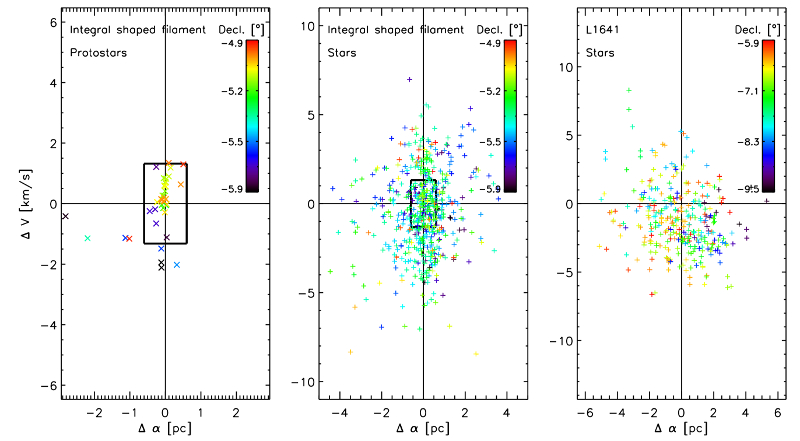| EPoS Contribution |
|
The Hunter's slingshot: Protostellar ejection from filaments in Orion
Amelia Stutz MPIA, Heidelberg, DE | |
| Stars (both massive and puny) form in clusters. By scrutinizing the nearest laboratory for a cluster in formation (Orion A's Integral shaped filament; ISF) we gain new insights into cluster-formation physics. By comparing 3 constituents of Orion A (gas, protostars, and pre-main-sequence stars), both morhologically and kinematically, we show the following. Essentially all Class 0 and Class I protostars lie superposed on the ISF, while almost all pre-main-sequence (Class II) stars do not. Combined with the fact that protostars move < 1 kms relative to the filaments while stars move several times faster, this implies that a slingshot mechanism may eject protostars from the dense filamentary craddle, thereby cutting off their accretion of new gas. The ISF is the 3rd in a series of star bursts that are progressively moving south, with separations of ~ 2 Myr in time and 3 pc in space. This, combined with the filament's observed undulations (spatial and velocity), suggest that repeated propagation of transverse waves thru the filament is progressively digesting the gas that formerly connected Orion A and B into stars in approximately discrete episodes. The presence of transverse waves implies the action of a buoyant restoring force acting against gravity. Combined with previous observations of magnetic field geometry in this and other filaments, this suggests that the ISF transverse waves are magnetically induced. In this scenario, protostellar ejection from filaments occurs because the gas accelerates away from the protostars, not the other way around. This can be dirrectly tested in the very near future in Orion A through GAIA proper motion observations. | |
 | |
| Caption:
Offsets of ISF protostars (left), ISF stars (center), and L1641 stars
(right) from the filament ridgelines in space (alpha) and radial
velocity. The protostars are shown only for the ISF because of the
difficulty of capturing the filament structure further south by simple
prescriptions. Points are color-coded north-to-south -->
red-to-blue. Ratio of axis scales is 1 Myr. Hence, the
vertically-elongated structure of these diagrams indicates timescales
<< 1 Myr, < 1 Myr, and ~ 1 Myr for the three diagrams, respectively.
These could be either lifetime or turnaround time. The Class II YSO
(labeled "stellar" here) distributions (both ISF and L1641) are
broadly distributed, with no obvious "filament-hugging"
subpopulations, like the ISF protostars. However, they also show
significant lumpiness demonstrating incomplete relaxation. The
protostars show some severe clumping, with a high density near the
origin, in particular. We find mean projected quantities | |
| Collaborators: A. Gould, MPIA, DE / OSU, US |
Key publication
Suggested Session: Cluster Formation |

